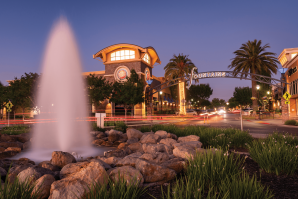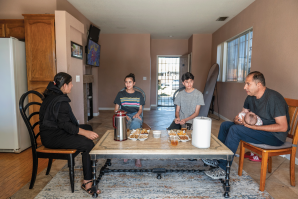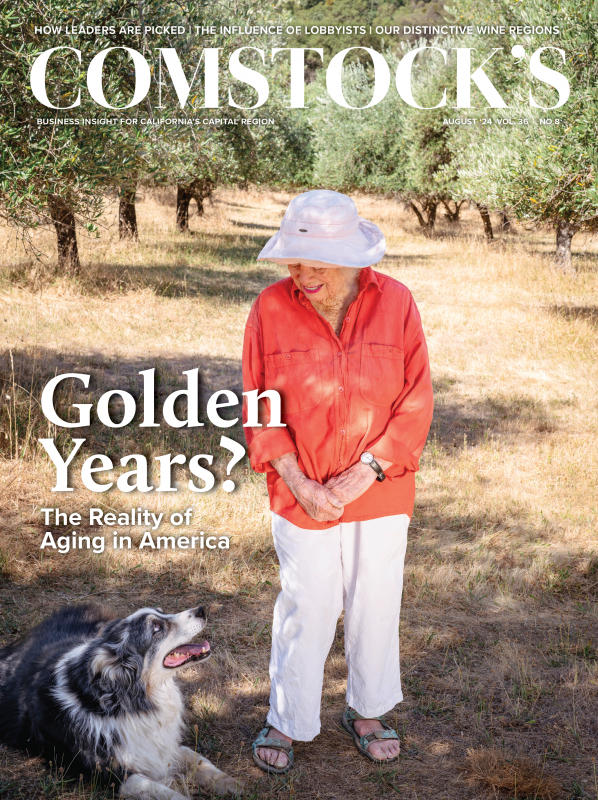There is great wine being made in the Capital Region by passionate winemakers who learned the art at UC Davis Viticulture and Enology school or had the knowledge passed down from a previous generation. They planted grapevines in beautiful locations, even if the soil was rocky or dry, because they knew the end product would be something wonderful and enjoyed by many. These wineries sell affordable, quality wines, yet people still drive to Napa Valley to spend $35 to $75 on tasting fees to bring home a $100 bottle of wine. Foothill wineries, long overshadowed by Napa, are fighting to be recognized more.
Each of our four wine regions has its own unique terroir, a French term describing the soil, climate and sunshine that give wines their distinct character. These winemakers want consumers to consider their wines farm-to-fork — that is, farm-to-glass.
El Dorado County
As you’re driving east on Highway 50, the road twists and turns as you climb into the Sierra Nevada foothills. It switches from the flat terrain of Sacramento into a mountain region laced with pine trees, freshwater lakes and the clean, crisp scent of mountain air. El Dorado County, with about 70 wineries, is the perfect spot for a Hallmark movie — but instead of hot cocoa, the lovers would sip wine.
Fall at Miraflores Winery, located in Placerville. (Courtesy
photo)

No wonder El Dorado County winemakers are working to capture this fresh essence into their wines. The El Dorado American Viticulture Area, or AVA, has the distinction of being one of the few appellations in the U.S. defined by elevation. In this wine growing region, grapes are grown from 1,200 to 3,500 feet. The Sierra snowmelt that provides irrigation and the cool alpine downward draft winds that blanket the vineyards all contribute to the makeup of the wine.
The El Dorado 8 is a group of wineries who are working together to promote their region. It’s one of the few places in the U.S. where the high elevation has the grapes pick up essences of Ponderosa pine trees, which they call Sierra Spice — a subtle flavor of vanilla and cinnamon that emanates from the trees.
“Our appellation goes from 1,200 feet on the low side to 3,500 feet on the high side,” says winemaker Greg Boeger of Boeger Winery, one of the El Dorado 8. “Then you have the slope exposure that can moderate the location you want” to plant vines.
Wine is not new in El Dorado County. It began along with the Gold Rush, with John Sutter himself being an early winemaker. It thrived until Prohibition shut it down. Boeger and his wife, Sue, were the first to establish a continuing operating winery in the region in 1972.
Others soon followed, attracted to the rich, deep soil born from lava flows more than 100 million years ago. Most of the vineyards in El Dorado are planted in volcanic, granitic and rocky slate soils.
Lava Cap Winery is located in El Dorado County, which is one of
the few appellations in the U.S. located at a high elevation.
Wines made here reflect the crispness of the mountain air, water
and surrounding pine trees. (Courtesy photo)

Winemaker Nolan Jones of Lava Cap Winery in Placerville says the higher elevations of El Dorado County distinctively impacts their wine, especially their popular chardonnay. “Its freshness, its brightness, its citrus. The wine really showcases what high elevation wine tastes like,” he says.
The daytime temperatures in the county are 10 degrees cooler than the lower-elevation Sacramento region. That allows the chardonnays to display crispness, with notes of Meyer lemon and tropical fruit. Because the grapes get more UV radiation than they do at lower elevations, the reds develop balanced tannins, structure and increased color intensity.
Despite the big mountain boulders and fractured rocks left behind by gold mining blasts, the vines still make their way through the mountain soil. “We hit impenetrable rock, but the vines still find their way into it,” Jones says.
Lodi
As you drive down Highway 99 toward Lodi, the landscape changes from a city skyline to suburban strip malls to farmlands. Lodi was once an essential agricultural area, growing wheat, then watermelon, until farmers discovered the terrain was very good for growing wine and table grapes. In fact, the first vineyard was planted in Lodi in 1850, and by 1901, a local newspaper declared wine production “is the coming industry for this part of the state.”
The vineyards of the Lodi region are among the oldest in
California. They’re known for their gnarly and bold old vine
zinfandels that come from some grapes planted more than 150 years
ago. (Photo by Stephanie Russo, courtesy of Lodi Winegrape
Commission)

In 1905, the Woodbridge Wine Association was created, better known today as Woodbridge by Robert Mondavi. When Prohibition arrived from 1913 until 1933, an exemption in the law allowed homemade wine to be made, so Lodi winemakers shipped their grapes across the country for home winemaking.
A hundred years later, Lodi is responsible for 20 percent of California’s wine production, with 130 premium varietals planted on 100,000 acres at 85 wineries, according to the Lodi Winegrape Commission. Lodi wine grapes also get shipped to wineries all across the U.S. Cabernet sauvignon is the wineries’ largest grape by volume, but some of the other varieties include Greek and Spanish wines and wines from the Rhone region of France. The region also produces more than 30 percent of California’s premium zinfandels, with some gnarly, original old vine zins still thriving and producing after 150 years.
Lodi enjoys a Mediterranean climate with cool, moist winters and dry summers, where Delta breezes coming off the San Francisco Bay at night drop temperatures 40 degrees and contribute to fragrant, fruit-focused wines.
“What that does is not only the temperatures drop at night, which allows the grapes to retain their acidity and freshness,” says Stuart Spencer, executive director of the Lodi Winegrape Commission. “They deliver a really pure fruit flavor, the sandy soils which allow these really old vineyards to survive and thrive. And the style of wine that comes from a sandy soil vineyard.”
Another distinguishing feature in the Lodi area is its diverse soils that were formed thousands of years ago through geological events and alluvial waters — deposits from the rivers and Sierra Nevada that are filled with clay, silt, sand or gravel. Two major rivers that originate in the Sierra — the Mokelumne and Cosumnes — produced soils rich in granitic-based minerals. “Sandy loam right around the community of Lodi has the potential to produce very perfume-style wines,” Spencer says.
Rows of mustard line a vineyard in Lodi. (Photo by Stephanie
Russo, courtesy of Lodi Winegrape Commission)

Around the 2000s, Lodi was known for its big, bold jammy red wines, especially old vine zinfandels produced at Michael-David Winery and others that are made from juicy ripe grapes. For several years, the community had a wine festival around them called Zinfest at Lodi Lake. The current trend is for a lighter style, low alcohol, fresh or fruit-flavored wines.
“In Lodi, you will find more acres of old, own-rooted vineyards (growing on its own roots rather than from a stock) than anywhere else in California,” Spencer said.
Clarksburg-Delta
There’s something special about driving along the levees of Clarksburg, with abundant water and wetlands on either side, that tells you you’re someplace different and unique. Less than a 30-mile drive from downtown Sacramento, you’re transported to another region that’s slower paced and almost a step back in time, when things were a bit simpler than today’s frantic lifestyle.
The Delta breeze, alluvial soil and abundant access to water
makes Clarksburg ideal for growing grapes. (Courtesy photo)

Clarksburg, with a population of just 402 people, according to the 2020 census, is verdant with fertile farmland. Sugar beets and asparagus were once the main crops in the 1920s until they got too expensive to grow. Now there are lovely pear farms that produce juicy, fragrant fruit that’s turned into award-winning cider and pies. There’s also 10,000 acres of vineyards bursting with ripe, flavorful grapes in this Yolo County region that also includes a portion of Sacramento County.
The Bogle family discovered that abundant earth back in the 1870s. Before most of the levees were built, the island would flood, bringing in sediment from the Sacramento River. The soil in the region is alluvial, meaning it’s a mixture of clay and loam. The clay retains moisture as a nutrient, and the loam allows for drainage, which is good, because vines should not be soaking in water.
“The better soils in our area are generally pretty much closer to the waterways,” says Warren Bogle, president and vineyard manager at Bogle Wines.
Eric Aafedt, the vice president of winemaking, says the unique climate of the Clarksburg-Delta region makes all the difference in the wines that come from the region.
“Our biggest differentiation is the climate cooling from the San Francisco Bay. That air comes ripping up the river every afternoon and just blows out all the hot air here, and gives us a lot cooler evenings than the surrounding areas. So with the cooler evenings, longer maturation, longer hang time on the vine, and you also retain more acidity. So what you like to see is a longer maturation on the vine, the more developed character of the wine,” says Aafedt, who’s been making wine for Bogle for 30 years.
Eric Aafedt has been the winemaker at Bogle Winery for 30 years.
He’s seen winemaking go from formulations handwritten in
notebooks to now entered into computer software. (Photo courtesy
of the Bogle Family Wine Collection)

That longer vine “hang time” allows red grapes to develop a deeper color and more intense, rich flavor. Chardonnay, their largest crop, has a green apple with pear aromatic, along with a bit of peach and tropical notes. Petite syrah, one of the original wine varietals planted, has notes of black pepper and boysenberry.
Bogle is known as a value brand but still ages their wines 12 to 16 months in 80 percent American-20 percent French oak barrels that add to their flavor and intensify the wine. “We’re barrel aging all of our red wines, and that is a pretty significant task to undertake for a $10 wine,” Aafedt says.
Bogle is the top producing winery in the Capital Region, with their wines in every U.S. state and 50 countries worldwide. They are one of 20 wineries in Clarksburg. For a taste of 14 wineries in one spot, visit the Old Sugar Mill, a historic building that was once a sugar beet processing plant.
Amador County
Driving alongside the lush, rolling vineyards of Amador County, one can almost get the feel of the European countryside. This is some of California’s oldest wine country, where Gold Rush artifacts can be found and where the longest-operating winery in the state — Sobon Estate — is commemorated with a plaque. When hopeful explorers came from all over the world to the Shenandoah Valley seeking gold, wineries started popping up to quench them. At one point, there were more than 100 wineries in the Mother Lode. Some of the vines planted in the 1850s are still thriving today.
A grapevine ready to harvest in Amador County. (Photo courtesy of
Life’s Little Blessings Photography)

The soil is rich with sparkling quartz, volcanic rock, sandy loam and granite, and according to the Amador Vintners Association, there’s even some gold sprinkled in among the roots of the grapevines.
“The key here is volcanic red soils, I would say, that impart a raw, silky texture to the wines and the dustiness to old vine zins. We also have clay and soil, like sandy soil on top of that,” says Holger Hornisch, tasting room manager at Rancho Victoria vineyard.
Amador has peaks up to 2,600 feet and valleys where the vines get sun-drenched. The climate is warm, with high luminosity and low humidity. Winemakers compare the climate to St. Helena, noting it can be cooler than Calistoga in the Napa Valley depending on the elevation and season. Once known mainly for their zinfandels, Amador also boasts bold barberas, smooth syrahs, sangiovese and viognier, along with other varieties. The high temperatures produce very ripe fruit and full-bodied, high alcohol wines. The county boasts one of the highest percentages of organically farmed vineyards of any wine region in California.
“Amador County is barbera and zin country. They’re very popular, so much so that wineries that aren’t producing a barbera wine are being asked to. The (Aug. 3) Barbera Festival is picking up in steam and popularity,” Hornisch says.
But he declines to make a blanket statement on what Amador wines taste like, saying that each wine is a winemaker’s vision and can be bold or light. “Barbera is a varietal that is very fruit forward and juicy, lighter fruits, not black fruits, so much,” he says.
–
Recommended For You

Recruiting Leadership
How big companies and organizations search for their leaders
As the Capital Region was recovering from one of the worst financial shocks in living memory, three organizations on the frontline of that comeback had to find new leadership at the same time. Comstock’s explores how their tactics worked and what lessons were learned along the way.

What Does a California Lobbyist Do?
Often referred to as the third house of the state legislature, lobbyists spend long days advocating for their clients
California is one of only 10 states that has a full-time professional legislature, and last year, companies and industries spent a record high $480 million on lobbying efforts in the state.

When the Sun Sets on the Golden Years
The hardship and high cost of caring for a loved one in decline
For eight weeks in the summer of 2023, Laurie Watkins took leave from work to be her mother’s live-in caregiver. She had joined what is often referred to as the sandwich generation — those who are caring for both their children and their aging parents.

Sleepy Suburbs? No Way
These Capital Region cities are buzzing with energy and ambition
A generation ago, Sacramento was the undisputed king of commerce and culture in our region. But the once-quiet suburbs are growing up fast. In fact, thanks to years of quiet community building, the edge cities are leading the way in defining the modern Capital Region.

The Changemakers
The people who’ve shaped the Capital Region over the past decade
The Capital Region has seen a stunning metamorphosis over the past decade. These changes didn’t happen on their own; they occurred due to the work and vision of a range of notable people, from developers and public officials to sports executives and innovators.

The Great Migration
From immigrants fleeing their countries to Bay Area residents escaping high prices, the culture of the Capital Region is changing
Just under 2.4 million people live in the Sacramento-Roseville-Folsom metropolitan area, an increase of roughly a quarter since the turn of the century.





